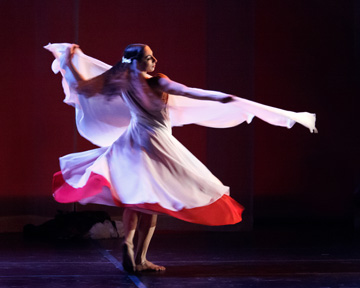The pent-up energy and creativity of the Persian diaspora exploded in a spectacular way when the Persian Arts Society recently mounted THE SCARLET STONE at UCLA’s Royce Hall.

Based on a famous Persian epic poem, the Shahnameh by Ferdosi, and a 20th-century
work, Mohreye Sorkh, by the late Siavash Kasrai, THE SCARLET STONE wedded
old and new in a seamless and fresh way. While a storyteller, in this
case Gorda Farid, the first female ever to take on such a traditional
role, related key passages of the text in a commanding voice, four dancers
acted out the story, framed by a lushly-colored set that called to mind
a royal salon. Five musicians, some of whom played instruments like the
tanbur, tombak and balaban, filled the air with the exotic sounds of ancient
Persia (score by Shahrokh Yadegari, who also adapted and directed THE
SCARLET STONE). At the same time, such modern touches as video projection
and electronic sound effects were employed, giving everything a contemporary
feel.
The story
itself, though rooted in the past, had obvious relevance as well. The
story focused on Sohrab, a young nobleman who believed deeply in justice
and equality, only to be killed on the battlefield by his ignorant father,
Rostam (symbol of paternalistic power and narrow-mindedness). The same
struggle which pits freedom vs. fundamentalism, youth vs. mullahs, is
taking place in Iran today, as we all well know.
The multi-disciplinary production of THE SCARLET STONE proved to be a
remarkable experience, with music, dance and spoken word combining to
bring Persian sensibilities to life in vivid, compelling fashion.